An enticing mix of historical architecture, picturesque views and sprawling vineyards await travellers to Salta, located in the lovely Lerma Valley in the Andean foothills. Simply wandering through the streets of the central city area will take you past a variety of impressive 18th and 19th-century buildings, including the neoclassical Cathedral of Salta, the ornate Church of Saint Francis and the Museum of High Mountain Archaeology – housing a collection of ancient Inca relics. Other popular attractions are the area’s array of exceptional wineries, and the panoramic views over the region visitors from the top of San Bernado Hill.



The ochre cliffs of the Cerro de los Siete Colores (The Hill of Seven Colours) form a magical backdrop to this charming rural village. The colourful layers have been formed over 600 million years by the accumulated deposits of sea, lake and river sediments. The unmistakeable image of the village against these multi-hued mountains can be found on postcards across the country. Every day there is a vibrant market in the central square, where locals and tourists can purchase clay pots, woven goods and handicrafts. Don’t miss a visit to the village church, Iglesia de Santa Rosa de Lima, which was declared a national monument in 1941.



As previously described



Located in northern Argentina and flanking the Rio Grande River, the UNESCO-listed Quebrada de Humahuaca is a narrow mountain valley known for its mesmerising rock formations and its indigenous Quechuan villages. The Hill of the Seven Colours (Cerro de los Siete Colores) is a rainbow masterpiece, while the limestone formation called Serrania de Hornocal presents a sculpture of triangular-shaped striped rockfaces. The desert valley holds evidence of life dating back 10, 000 years, from early hunter-gatherer tribes to pre-Hispanic communities, Incan culture, Spanish colonizers, and into the 20th century. The villages of Quebradea are filled with ancestral roots, as the indigenous peoples of the area still practise the same rites, festivals, art, music and agricultural techniques as they did hundreds of years ago, making this a unique place to experience traditional culture firsthand.



Resting in the picturesque of Quebrada de Humahuaca valley, the enchanting town of Tilcara is set in the Jujuy Province in northern Argentina. It is known for its rich traditions, scenic landscapes and delicious cuisine. Explore the steep streets lined with earth-and-straw brick buildings, or visit the pre-Hispanic Pucara Ruins, the Sculptures Museum, and a fascinating Carnival Museum. Other activities in and around the city include caravanning with lamas, visiting the local botanical gardens, and meandering along the Garganta del Diablo, an imposing waterfall in the Huasamayo River. Don’t miss a visit to the Dr Eduardo Casanova Archaeological Museum and the incredible Jose. A. Terry Museum to see superb paintings of local life.



Resting in the foothills of Argentina’s Andes Mountain Range, Mendoza has a rich gastronomic heritage, and produces some of Argentina’s most exceptional wines and olive oil. Gourmands can participate in tours and tastings at the many wineries and sample delicious local cuisine at the laid-back cafes. The city also boasts a number of historic attractions, most notably the Museo Fundacional which displays the town’s progress through human evolution, and the Museo Historico General San Martin which honours Jose de San Martin, the general who liberated Argentina from the Spanish. Other highlights include: charming, well-kept parks; bustling, fountain-adorned plazas; and the opportunity for picturesque hiking, skiing and rafting in the nearby Andes. Several exquisite churches and art-deco architecture add to the town’s landscape.



Resting in the foothills of the Andes in western Argentina, Potrerillos is a district of the Luján de Cuyo Department in the province of Mendoza. The district features some exceptional natural scenery and serves as a popular eco-tourism destination with a range of outdoor activities on offer including canoeing, hiking, fishing, white-water rafting, windsurfing, kayaking, and camping. The lovely Mendoza River meanders past the eastern edge of the town of Potrerillos and discharges into the exquisite trout-filled Potrerillos Dam. The banks of this dam and river are fringed by an array of cabins and inns, providing a peaceful retreat away from the city of Mendoza which lies only 60 km to the south. Must-see sights of the surrounding area include: the small but charming Vallecitos ski resort and the healing hot spring waters of Cacheuta.



Uspallata is an Andean settlement located in Argentina's Mendoza Province, close to the Chilean border. The town is set at an altitude of 6,690 feet above sea level and surrounded by desert mountains and a petrified forest. Places of interest in Uspallata include the ruins of the Paramillos Mines, the 17th-century kilns which are shaped like eggs and a small museum.



The Argentinian Lake District’s most popular destination, San Carlos de Bariloche, commonly called Bariloche, is a city for all seasons. It features a setting second to none – stretching along a glacial lake shoreline, surrounded by a national park in Argentina’s pristine Patagonia region. The region offers myriad activities and leisure opportunities: whether you want to go skiing, hiking, fly-fishing, or simply kick back and indulge in an epicurean feast, it’s all there for the taking. The city's numerous cafés and chocolate shops are a delight to explore by day; while after sunset, the city lights up with bars and nightclubs, where locals and visitors can dance the night away. Don't miss the opportunity to view the unique Swiss alpine-style architecture and discover the spectacular surrounding Andes Mountains.



Argentina's Lake District is a wilderness wonderland of pristine glacial lakes, cascading waterfalls, snow-capped mountains and forested valleys where condors fly overhead. A playground for nature lovers and adventure seekers alike, travellers to this spectacular setting can go trekking, fishing or skiing, or simply relax and soak up the scenery. While nature is the prime attraction here, the region encompasses several charming towns that act as gateways for exploring the surroundings. Arguably the most enticing of all these is beautiful Bariloche - set on Lake Nahuel Huapi's banks against rugged, snowy peaks that have earned it the nickname 'Argentina's Switzerland'. Another lovely stop is San Martín de los Andes, on Lake Lácar beneath the Mount Lanín volcano. This beguiling village has a shabby-chic charm - its slightly dilapidated buildings interspersed with rambling rose bushes and spiky 'monkey puzzle' trees.


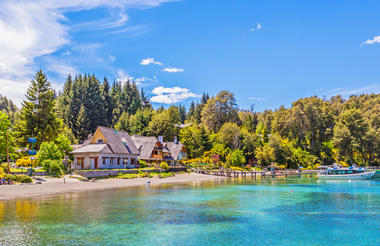
Idyllically situated in the Los Glaciares National Park in Argentina’s Santa Cruz province, the village of El Chaltén is known as Argentina's trekking capital. It is a popular haven for outdoor enthusiasts with hiking opportunities abound for both advanced and beginner trekkers. Just an hour’s walk can lead you straight to the treasures of Los Glaciares National Park, which range from great glaciers to towering rocky summits and rolling forests. Founded in 1985, the town got its name from the Tehuelche word meaning ‘mountain that smokes’, because of the clouds that persistently sit atop the great peaks. The Perito Moreno Glacier and the Laguna de Los Tres, a picture-postcard mountain lake with the snowy backdrop of Fitz Roy peak, are the most visited sites.



Situated deep in Patagonia’s snow-capped vistas, on the southern shore of Lake Argentino, El Calafate has become a key stopover for travellers headed to nearby Los Glaciares National Park. This icy wonderland is best known as the home of spectacular Perito Moreno glacier – a massive, shifting ice cap composed of dozens of smaller glaciers. Take a glacier tour, a helicopter ride, or a 4x4 excursion; hike and boat to your heart’s content; or visit one of the traditional ‘ranchos’ (estancias) to learn more about local culture (another great spot for this is the Centro de Interpretacíon Historico). A wonderful selection of restaurants and boutiques adds appeal; make sure to try the ‘alfajores’ cookies. Drink vodka, watch a movie, and learn all about ice at the impressive Glaciarium.



Known for its spectacular beauty, Torres Del Paine National Park is a rich biosphere reserve in Chile’s Patagonian region. The park stretches over 242 000 hectares of magnificent landscape, featuring snow-capped mountains, ancient glaciers, cascading waterfalls, golden grasslands and several lakes that attract a variety of water birds. Three iconic granite pillars of the Torres del Paine tower over the landscape of emerald forests and the impossibly blue lake. Travellers may be able to spot the endemic guanaco llama, Andean condor, foxes, cougars, guanacos, Chilean Huemul, and around 15 birds of prey. Neighbouring Bernardo O'Higgins National Park to the west and the Los Glaciares National Park to the north, Torres Del Paine is the perfect place for extended trips in the Chilean wild.
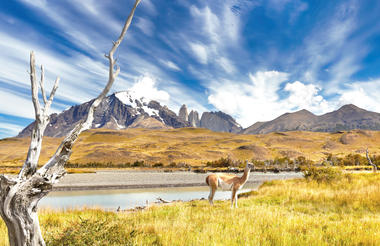
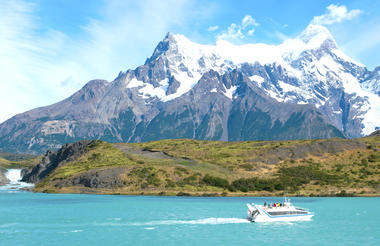
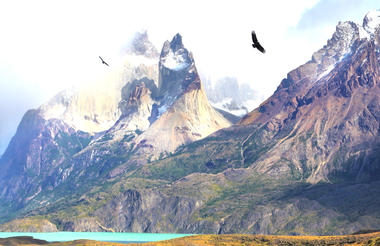
Situated in the Austral Andes in the Santa Cruz Province of southwest Argentina, the Los Glaciares National Park is known for its magnificent natural beauty. Glacial lakes, towering mountains and majestic glaciers merge to create an awe-inspiring spectacle of nature. It is the largest national park in the country, stretching over 7000 square kilometres. This UNESCO World Heritage site features a sprawling collection of spectacularly beautiful glaciers. Perito Moreno, one of the most famous glaciers because of its dynamic changes, can be seen in the southern area of the park; whilst granite peaks and forests characterise the northern area of this world-renowned park. Visitors can explore the mountain village of El Chalten, soak up the dramatic views of the glaciers with their calving ice falls into Lake Argentino, and discover the various types of Andean-Patagonian Forest, Patagonian Steppe and unique high-altitude vegetation blanketing the landscape.



Widely regarded world’s southernmost city, Ushuaia is a strikingly beautiful destination on the southern coastline of Tierra del Fuego Island, backed by mountains and facing onto Beagle channel. The city’s elegant commercial centre offers a variety of cultural and entertainment activities, while its natural location means that adventure enthusiasts are spoilt for choice, with kayaking, skiing, hiking and sailing all on offer. For a more serene excursion, boat cruises are a popular way to view the glacier off Ushuaia’s coast.
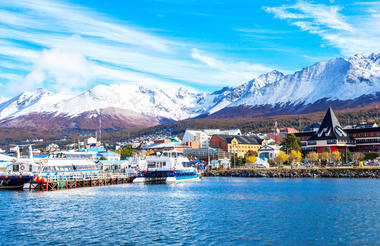
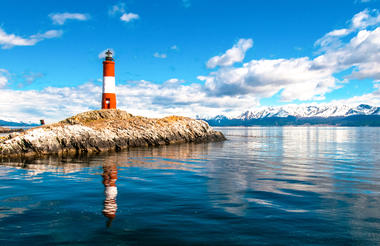

The world-famous Tierra del Fuego National Park is situated on the Argentine part of the island of Tierra del Fuego and was the first shoreline national park established in Argentina. The park is famous for its sublime views, fascinating history and unique environment. Featuring bright turquoise fjords, green forests close to the coast, and lush valleys created by parallel mountain ranges, the stunning scenery offers breathtaking views and extraordinary photographic opportunities, especially from the renowned lookout point at Lapataia Bay. History enthusiasts can see the ‘concheros’, circles where mollusks accumulated, showing that there were ancient yamanas aboriginal tribes living in the area hundreds of years ago (their main food was seafood). The remarkable Canadian Beavers can be seen from a distance along with their incredible dam systems, which have played a significant role in the environment.



Set at the southern tip of South America, Tierra del Fuego Province is a scenic province in the southernmost reaches of Argentina. Said to be one of the world’s final frontiers, this region boasts breathtaking scenery, incredible wildlife and rich cultural heritage. This corner of Patagonia provides endless activities and attractions for thrill-seekers and nature lovers. It boasts an array of natural wonders including ancient glaciers, untouched wilderness, national parks, pristine lakes, rivers and waterways. Don’t miss a visit to Ushuaia, the city set at the ‘end of the world’, which serves as the jumping-off point for expeditions to the Antarctic.








